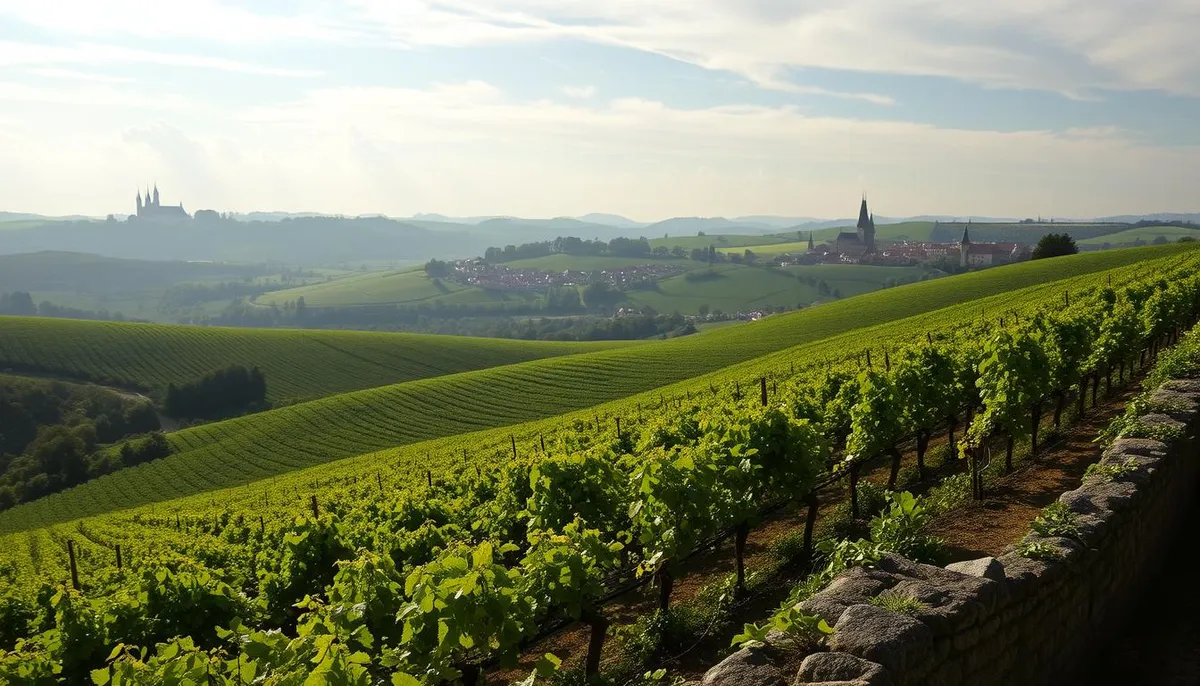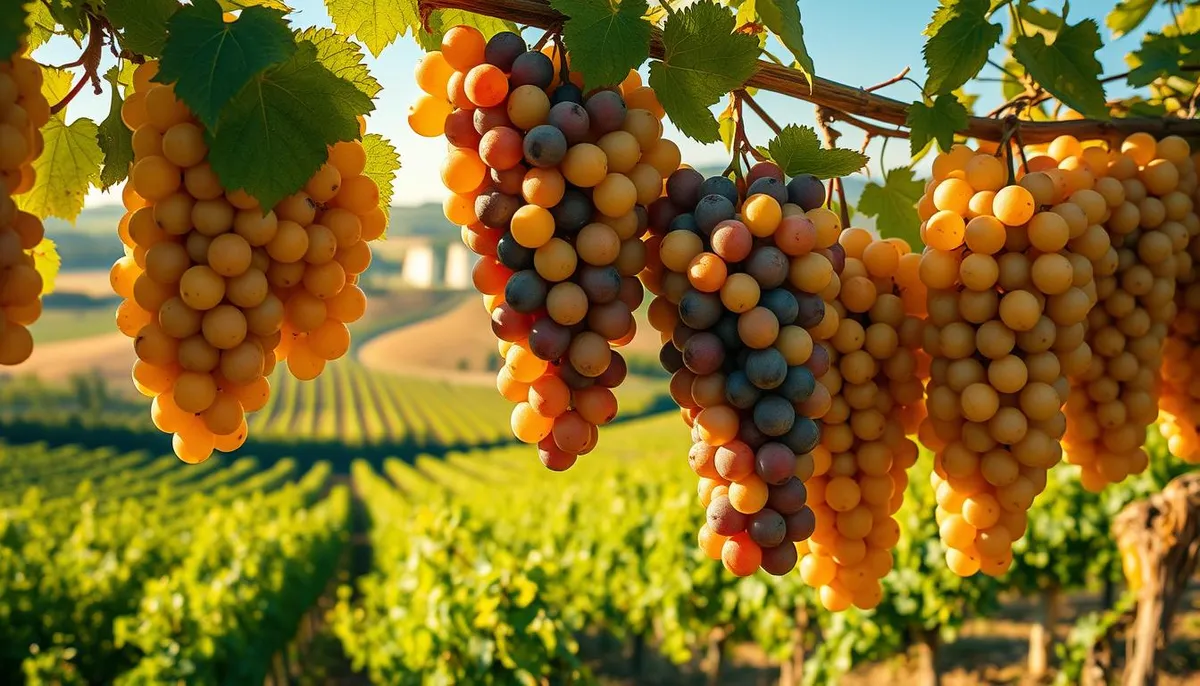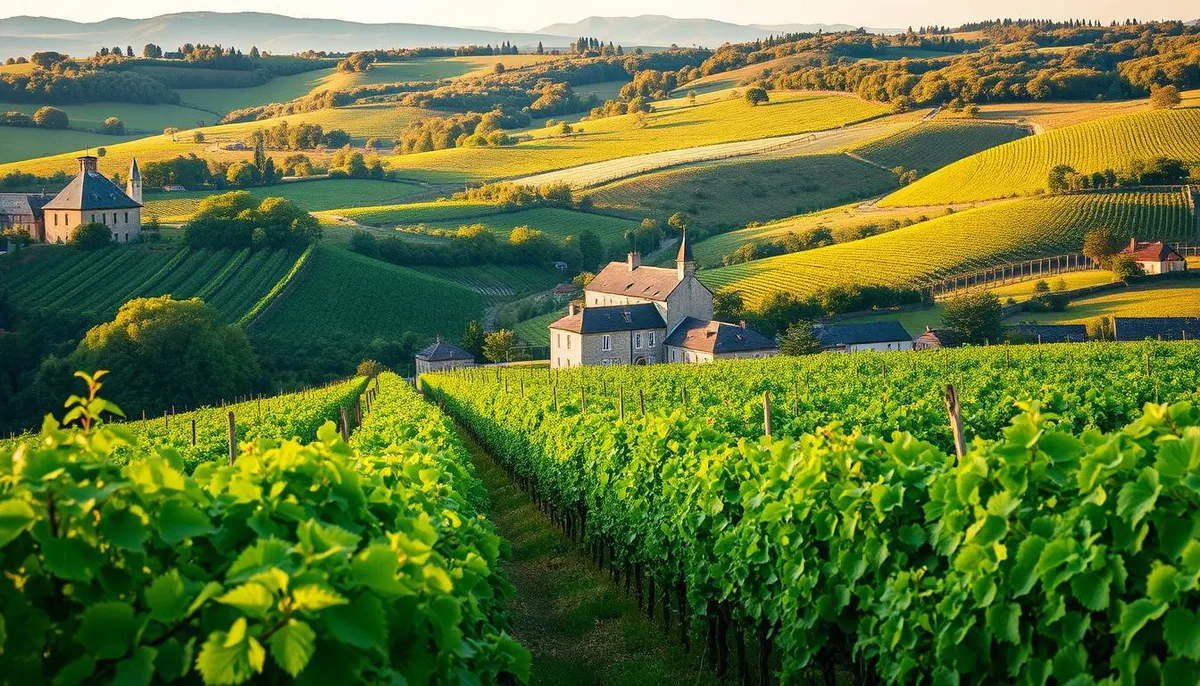Welcome to Champagne området frankrig, a treasure among franske vinregioner. This iconic wine region transcends mere bubbles; it’s a confluence of history, tradition, and unparalleled winemaking. Situated in northeastern France, Champagne stands as the pinnacle of sparkling wines globally.
Did you know that UNESCO recognized the “Champagne Hillsides, Houses and Cellars” as a World Heritage site on July 4, 2015? This recognition underscores the region’s profound cultural heritage and its pivotal role in the global wine industry. Spanning 34,000 hectares of AOC-designated land, each plot plays a crucial role in crafting this celebrated sparkling wine.

Champagne’s acclaim has attracted imitators, yet true Champagne can only originate from this specific French region. The unique terroir, coupled with centuries-old winemaking traditions, renders it unreplicable elsewhere. From the chalky soils of Côte des Blancs to the diverse landscapes of Montagne de Reims, each sub-region imbues the final product with its distinct essence.
Seeking authentic Champagne? You’ve arrived at the right destination. We’re poised to navigate you through the finest selections from Champagne området frankrig, destined for export and enjoyment worldwide. Embark with us on this captivating exploration through one of France’s most cherished wine regions!
Key Takeaways
- Champagne området frankrig is a UNESCO World Heritage site
- The region covers 34,000 hectares of AOC-designated land
- Only wine from this specific French region can be called Champagne
- Champagne’s unique terroir contributes to its distinctive character
- The region is divided into four main areas, each with its own specialty grapes
- Authentic Champagne is available for export worldwide
The UNESCO Heritage Status of Champagne Region
In 2015, the Champagne region was awarded UNESCO World Heritage status. This recognition acknowledges its distinctive vinmarker i champagne and ancient winemaking traditions. Spanning approximately 34,000 square kilometers, the designation includes the region’s slopes, houses, and cellars.
Historical Recognition and Cultural Significance
The UNESCO status underscores the Champagne appellation’s profound history and cultural significance. With over 15,000 producers, Champagne significantly contributes to the French economy, generating around 4.7 billion euros annually. The vineyards, covering about 34,300 hectares, uphold traditional methods and quality standards.
Protected Wine Landscapes
The UNESCO designation protects Champagne’s unique landscapes. The region boasts five primary grape varieties: Chardonnay, Pinot Noir, Pinot Meunier, Pinot Blanc, and Pinot Gris. These vinmarker i champagne are essential for preserving the region’s wine character.
Cultural Impact on Global Wine Industry
Champagne’s UNESCO status has amplified its global reputation. In 2021, over 264 million bottles were exported to international markets. The region’s wine tourism sector drew about 5 million visitors in 2019, attracted by wine and culinary experiences. This global interest highlights Champagne’s lasting impact on the world wine industry.
Understanding Champagne området frankrig: Geography and Terroir
The Champagne region in France is a distinctive wine area, spanning approximately 34,300 hectares of vineyards. It is home to over 14,000 registered grower-producers. These producers are instrumental in the annual production of around 300 million bottles of sparkling wine. For those interested in exploring this unique area, champagne region travel offers a chance to experience the beauty and culture of Champagne firsthand.
The AOC-Designated Areas
The Champagne region is segmented into four primary areas: Montagne de Reims, Vallée de la Marne, Côte des Blancs, and Côte des Bar. Each area boasts unique characteristics. Approximately 17.6% of the region is designated as Grand Cru, while 40% is classified as Premier Cru.
Soil Composition and Climate
The soil in Champagne predominantly consists of chalk and limestone, which is ideal for the main grape varieties. The region’s cool climate, with average annual temperatures ranging from 10.7°C to 11.2°C, significantly impacts grape quality. This cool climate is a key factor in the distinctive character of Champagne wines.
Regional Microclimates
Within Champagne området frankrig, various areas possess unique microclimates. For instance, Bouzy, renowned for its Pinot Noir grapes, benefits from a warmer microclimate. These microclimates contribute to the diverse flavors found in Champagne wines.
| Grape Variety | Percentage of Vineyard Area | Characteristics |
|---|---|---|
| Pinot Noir | 38% | Primary grape, adds body and structure |
| Chardonnay | 30% | Brings elegance and finesse |
| Other Varieties | 10% | Contribute to complexity and balance |
Noble Grape Varieties of Champagne
Champagne’s distinctiveness is rooted in its noble grape varieties. These grapes are the cornerstone of this renowned sparkling wine. Each variety brings its own unique characteristics to the blend, shaping the wine’s essence.
Pinot Noir: Power and Generosity
Pinot noir druer are indispensable in Champagne production. Predominantly found in the Montagne de Reims, these grapes infuse the wine with robustness and depth. Pinot Noir’s contribution is significant, providing a solid foundation for many blends.
Chardonnay: Elegance and Finesse
Chardonnay druer flourish in the Côte des Blancs’ chalky soils. This variety is celebrated for its elegance and finesse, essential to Champagne’s refined character. It introduces crisp acidity and delicate floral notes, crucial for achieving balance and sophistication in the wine.
Pinot Meunier: Fruitiness and Balance
The meunier drueklasser, though often underappreciated, are crucial to many Champagne blends. Grown mainly in the Vallée de la Marne, Pinot Meunier enhances the wine’s fruitiness and freshness. Its ability to harmonize the blend and offer immediate appeal to young Champagnes is unmatched.

| Grape Variety | Main Region | Key Characteristics |
|---|---|---|
| Pinot Noir | Montagne de Reims | Power, Structure, Depth |
| Chardonnay | Côte des Blancs | Elegance, Finesse, Acidity |
| Pinot Meunier | Vallée de la Marne | Fruitiness, Freshness, Balance |
Traditional Champagne Production Methods
The fransk vinproduktion of Champagne adheres to the Méthode Champenoise, a meticulous process refined over centuries. This method is responsible for the exquisite sparkling wines we cherish today.
The process commences with initial fermentation, followed by a second fermentation in the bottle. This step is crucial, as it generates the signature bubbles that characterize Champagne. Additionally, a champagne wall for parties can enhance the celebratory atmosphere. Aging is also pivotal, with non-vintage Champagnes requiring at least 15 months on the lees. Vintage selections, on the other hand, demand a minimum of 3 years.
Historical figures have significantly influenced Champagne production. Dom Pérignon, in the 18th century, pioneered by blending wines from different vineyards and grape varieties. Madame Clicquot, known as “the great lady of Champagne,” later innovated, further refining the technique.
The fransk vinproduktion of Champagne encompasses several critical steps:
- Riddling: Gradually tilting and rotating bottles to collect sediment
- Disgorgement: Removing the collected sediment
- Dosage: Adding a mixture of wine and sugar to balance flavors
While modernization has introduced automation, the Champagne region’s strict regulations safeguard traditional methods. This dedication to quality and tradition distinguishes Champagne in the sparkling wine realm.
Distinctive Champagne Styles and Classifications
The champagne appellation, a pinnacle among franske vinregioner, presents a spectrum of styles, including premier wines and rare husky colors. Each variety embodies distinct traits, mirroring the terroir and winemaking heritage of the region.
Blanc de Blancs
Blanc de Blancs champagne is a creation of Chardonnay grapes alone. It is celebrated for its sharp, refined character, with hints of citrus and minerals. This style epitomizes the essence of the Côte des Blancs subregion within the champagne appellation.
Blanc de Noirs
Blanc de Noirs, on the other hand, is derived from red grapes, namely Pinot Noir and Pinot Meunier, or a combination thereof. Despite its red grape origins, the wine’s appearance is golden due to minimal skin contact. This variety boasts a more substantial body and a richer palette of fruit flavors.
Rosé Champagne
Rosé champagne can be crafted through two distinct methods within the champagne appellation. The first involves a brief maceration of red grapes to impart color. The second employs blending still red and white wines from the region. Both approaches yield a pink-hued champagne, characterized by berry notes.
| Style | Grapes Used | Characteristics |
|---|---|---|
| Blanc de Blancs | 100% Chardonnay | Crisp, elegant, citrusy |
| Blanc de Noirs | Pinot Noir and/or Pinot Meunier | Full-bodied, rich fruit flavors |
| Rosé | Blend or maceration of red and white grapes | Pink hue, berry notes |
These unique styles underscore the champagne appellation’s versatility, catering to a diverse array of tastes. They offer wine aficionados a broad spectrum of flavors and experiences from one of France’s most revered wine regions.
Major Champagne Regions and Their Characteristics
Champagne’s diverse terroir gives rise to distinct wine styles across its four main regions. Each area boasts unique soil compositions and microclimates, shaping the character of its wines. Let’s explore these regions and their contributions to the world of sparkling wine.
Montagne de Reims
The Montagne de Reims, home to prestigious vinmarker i champagne, is renowned for its Pinot Noir grapes. This area produces powerful, full-bodied Champagnes. The village of Bouzy, located here, is notably famous for its rich, robust wines.
Vallée de la Marne
The Vallée de la Marne is the kingdom of Pinot Meunier. This grape variety thrives in the region’s cooler climate, lending fruitiness and approachability to many rosé Champagnes. The area’s wines often display notes of red fruits and a round, supple texture.
Côte des Blancs
South of Épernay lies the Côte des Blancs, a paradise for Chardonnay. The chalky soils here produce elegant rings, refined Champagnes with crisp acidity and delicate floral notes. These wines, along with high-end outdoor furniture, are prized for their finesse and aging potential.
Côte des Bar
The southernmost Champagne region, Côte des Bar, has a more continental climate. It’s known for lighter-style Pinot Noir wines that offer freshness and red fruit flavors. This area’s unique terroir contributes to the diversity of Champagne styles.

| Region | Primary Grape | Wine Characteristics |
|---|---|---|
| Montagne de Reims | Pinot Noir | Full-bodied, powerful |
| Vallée de la Marne | Pinot Meunier | Fruity, approachable |
| Côte des Blancs | Chardonnay | Elegant, refined |
| Côte des Bar | Pinot Noir | Light, fresh |
Vintage vs. Non-Vintage Champagne
In the world of fransk vinproduktion, Champagne is renowned for its distinct classification system. This system differentiates between vintage and non-vintage wines, each providing a unique tasting experience.
Non-vintage Champagnes are the majority, making up about 90% of all production. These wines are a blend of grapes from various years, aiming for a consistent house style. Many Champagne houses also offer elegant glassware, such as polish crystal champagne flutes, that enhance the tasting experience. Champagne houses heavily rely on these, as they constitute nearly 80% of their sales.
Vintage Champagnes, in contrast, are made from grapes harvested in a single, exceptional year. They must age for at least three years before release, with many producers aging them for five years or more. These wines capture the essence of a specific growing season, making them highly sought after by collectors.
| Champagne Type | Production Share | Minimum Aging |
|---|---|---|
| Non-Vintage | 90% | 15 months |
| Vintage | 10% | 3 years |
The Champagne region covers approximately 33,000 hectares, with 70% classified as AOC. This vast area produces an astonishing 320 million bottles each year. It highlights the grand scale of fransk vinproduktion within this iconic appellation.
Prestigious Cuvées and Notable Producers
Champagne’s prestige cuvées stand as the epitome of fransk vinproduktion. These wines epitomize the zenith of what a Champagne house can produce. They often incorporate Grand Cru grapes or employ unique production methods.
Historical Significance
The origin of prestige cuvées traces back to 1921, when Dom Pérignon released its inaugural vintage. This milestone introduced a new benchmark for luxury Champagnes. It prompted other esteemed producers to emulate this excellence.
Modern Excellence
In the present era, prestige cuvées continue to redefine the standards of quality and innovation. Esteemed producers are at the forefront, merging traditional craftsmanship with cutting-edge techniques.
| Producer | Prestige Cuvée | Notable Features |
|---|---|---|
| Moët & Chandon | Dom Pérignon | Vintage only, iconic bottle design |
| Louis Roederer | Cristal | Created for Russian Tsar Alexander II |
| Krug | Grande Cuvée | Blend of over 120 wines from 10+ years |
These renowned producers are instrumental in maintaining Champagne’s luxury image. Their prestige cuvées, often commanding premium prices, are highly coveted by collectors and connoisseurs globally.
The commitment to excellence in fransk vinproduktion is palpable in these prestigious cuvées. They not only showcase the pinnacle of Champagne but also underscore the region’s profound winemaking legacy and continuous innovation.
Conclusion
The champagne området frankrig epitomizes the synergy between nature’s bounty and human ingenuity. Situated within the franske vinregioner, it is renowned for its sparkling wine, embodying the pinnacle of luxury and festivity. Its UNESCO Heritage designation and distinctive terroir solidify Champagne’s status as a legacy in every effervescent drop.
Our journey through Champagne has unveiled the noble grape varieties, the traditional winemaking techniques, and the diverse styles that define its excellence. The region’s various areas, each with its unique flair, weave together to create a complex flavor profile in every bottle. From the robust Pinot Noir of Montagne de Reims to the refined Chardonnay of Côte des Blancs, Champagne invites exploration of a myriad of tastes.
Whether your preference leans towards the refreshing Blanc de Blancs or the intricate vintage cuvées, there’s a Champagne to suit every taste. Ready to embark on your own Champagne adventure? Visit https://champagne-export.com to discover a handpicked selection of fine Champagnes available for global export. Let the effervescence of this legendary wine region infuse your next celebration or intimate evening with joy.
RelatedRelated articles



